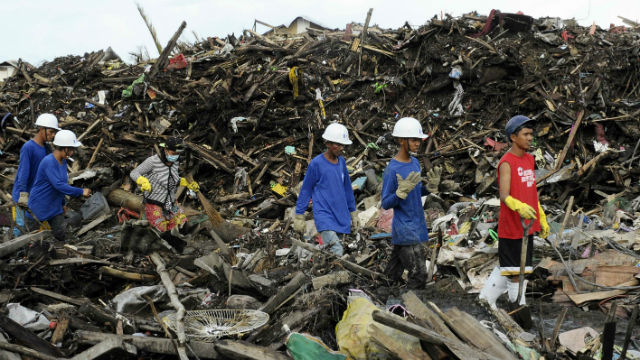SUMMARY
This is AI generated summarization, which may have errors. For context, always refer to the full article.

MANILA, Philippines – More than 20,000 workers who lost their livelihoods following Typhoon Yolanda (Haiyan) are now working in emergency employment programs (EEP), according to the International Labor Organization (ILO). This will speed up recovery of typhoon-hit communities and boost their local economies.
ILO country director Lawrence Jeff Johnson emphasized the role of EEPs in the recovery phase of disasters.
“Emergency employment provides a chance to reach out to workers and their families. This means making a difference in the lives of over 100,000 people by the end of 2013,” Johnson said.
According to ILO, the United Nations (UN) agency dealing with labor issues, EEPs help improve working and living conditions by (1) ensuring adequate wages, (2) effective safety and health, (3) skills development and (4) social protection that are aligned with national laws and standards. (Read: UNDP’s cash-for-work program to continue in 2014)
Johnson noted that decent work for an individual will ensure support for his/her entire family and will boost the local economy.
“Workers regain their strength and dignity. They are also motivated to work because they are aware that their families and communities will benefit from the emergency employment programmes…For real impact, it must be done in a sustainable way, something that this approach in partnership with the government addresses,” Johnson added.
ILO also said engaging local communities can create a multiplier effect which leads to sustainable recovery.
ILO strategy and the numbers
According to ILO estimates, the super typhoon affected 5.9 million workers. Around 2.6 million, or nearly half of the workers, were already in vulnerable employment and living at/or near the poverty line, prior to the typhoon. Some 3 million of the workers affected were in the services sector, 1.9 million were in agriculture and 1 million were in the industry sector.
ILO said workers in vulnerable employment are often forced to accept or create whatever work is available just so they and their families can survive.
The ILO approach, done in partnership with the Department of Labor and Employment (DOLE) and the Department of Social Welfare and Development (DSWD), consists of an immediate short-term emergency employment, which will then evolve into a medium-term labour-based community work, skills training and enterprise development.
This strategy had already been used to help the vulnerable who suffer the most in crises and disasters in countries like Cambodia, Indonesia, Sri Lanka and East Timor.
The UN agency called for the support of EEPs implemented by various agencies and the Philippine government. – Rappler.com
Add a comment
How does this make you feel?
There are no comments yet. Add your comment to start the conversation.